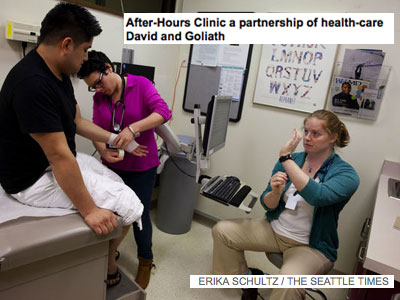President Obama last week relished his announcement that some 8 million people already have signed up for private health insurance under the Affordable Care Act, and that milestone sets the stage for a number of business angles related to the demand for and delivery of health care services:
Where’s the pent-up demand?
Curiously, a number of reports say that clinics and doctors’ offices are not seeing the surge of new health care consumers that had been expected. This column from the San Francisco Business Times, “Bay area Obamacare: Where are the patients?” reports some interesting observations from local health care systems; the absence of a big patient influx may be attributable to both a healthier cohort and new patients’ unfamiliarity with navigating a health care system.
What are your area’s primary care and specialty clinics and doctors seeing in terms pent-up demand, and is it what they expected?
Clinics.
Here’s an interesting Seattle Times read about a “David and Goliath” partnership to create an after-hours clinic next to a hospital ER; the clinic space was donated by the health care system but it’s staffed by the health care providers of a community-centered organization that now can afford to operate the clinic because more of its low-income patients will have insurance. Poke around your area for any similar initiatives.
Quickie clinics in retail stores, like the CVS Minute Clinics, are another fascinating area to watch; the Wall Street Journal in “Drugstores play doctor,” recently reported that the nation’s 1,600 no-appointment-needed retail clinics are expected to double over the next three years, with some of the nurse-practitioner-staffed treatment centers even expanding beyond the flu and sore throats to management of chronic conditions like diabetes (which is no doubt a lucrative area for expansion) The WSJ report cites this 2013 study by the consulting firm Accenture.
Clearly you can take a look at the clinic growth in your area and talk with your state’s biggest insurers about growth in patient claims that come via these operators. Are they cost-effective from the insurers’ point of view? We know doctors’ associations don’t like having their patients usurped but here’s a Houston Chronicle report on why consumers like them and why their share of pediatric patients is growing. What are doctors’ practices – with traditionally are open only during business hours, require appointments, keep patients waiting in exam rooms and otherwise discouraging would-be customers — doing to compete and win back patients?
Big bureaucratic health care systems seem to be getting the message; here’s a piece about a regional medical center opening a retail clinic in a Meijer general merchandise store.
And (anecdata alert!) I used a retail clinic New Year’s Eve for what turned out to be the flu – got there, examined, home and back, clutching my cough-syrup prescription, in 45 minutes flat — compared to a multi-day wait for an appointment at my regular doctor, a long sojourn in the waiting room and exam room, and then a separate trip to a pharmacy. It was an amazingly smooth and low-cost experience.
The nurse-practitioner seemed to really enjoy her job, too, from the patient care to being the solo manager of her own little clinic in the dynamic environment of a bustling store. You might take a look at the career possibilities these clinics offer for practitioners, as well.
And on a related note, this Forbes column highlights the expanding role of the pharmacist in health care delivery; it emphasizes the pharmacist as medical advisor, champion of adherence to prescription drug regiments (because non-compliance can lead to costly medical issues) and even giver of immunizations. The Pharmacy Times, an industry publication, asks “Is another credential in your future?” and notes that certification in areas like “geriatric pharmacy” is on the rise.










